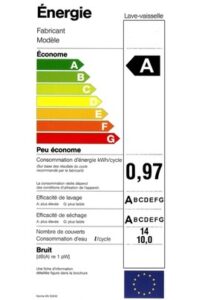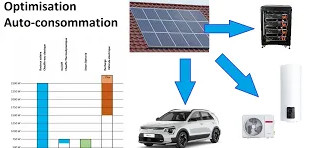Reduce consumption of your dishwasher
 I propose to have a look to dishwashers consumption. I will base this post on a specific device which is Bosch SMV53N4OEU. This one can be easily bought in France. This method can be of course reused with other models if you take care about the use range.
I propose to have a look to dishwashers consumption. I will base this post on a specific device which is Bosch SMV53N4OEU. This one can be easily bought in France. This method can be of course reused with other models if you take care about the use range.
 Consumptions
Consumptions
EN50242 norm oblige manufacturers to provide information about dishwasher consumption in particular cases. Those values are most of time related to eco modes of dishwashers. In the case of Bosch device here are those normalized consumptions :
- 9,5 l of water
- 0,92 kWh
Small mathematics courses
Take a sheet of paper and a pen. Water temperature at the input of dishwasher is fixed at 15°C +/- 2°C by the norm. Water is heated to 50°C in Eco mode. How much energy is used for heating water using the simple warming resistance ?
Don’t worry, I did the math : 0,386kWh are necessary to heat those 9,5 l of water per washing. If using dishwasher 1 day over 2 we should have a consumption of 70,2kWh per year to warm water.
With RT2012 and renewal of water heaters by new thermodynamic ones, we have much more effective systems to heat water in our houses than this simple resistance. Let’s use the this hot water instead of having the dishwasher to heat it.
By chance more and more devices accepts hot water with certain limits. This Bosch device can for instance input water as hot as 60°C.
 What could be the gain ?
What could be the gain ?
Thermodynamic heaters have in general a yearly mean COP around 2,5 ( very different of max COP values given by manufacturers). This could reduce consumption relative to water heating by a factor of 2,5. More than that the heater is consuming during the night, when electricity price is lower (0,1044€ for 1 kwh in France). The gain should be at least 2,94€ per year. Regarding the dishwasher lifetime this is not so ridiculous.
This value is to be modified in regards to the use you are doing of your dishwasher, temperature of cold water, the washer modes your are using, and variation of consumption from dishwasher itself.
More than that, the washing time will be reduced, no time is necessary to heat water. if hot water is also hotter than the eco mode one (55°C instead of 50°C for instance) , washing itself could be improved.
How to install ?
In general heaters are generating hot water around 50-55°C, so below the high limit of dishwasher. However some spikes at 65°C may regularly occur (anti legionella function), which is above the limit. Several solutions can be used :
- deactivate anti-legionella function and install a tap on the hot water pipe, costing 5€. This is not recommended because this water will be used to wash your dish !
- keep the anti-legionella function activated, and install the same kind of 5€ tap. Hopefully those higher temperature (65°C) won’t hurt too much your dishwasher (the seals should be the part that could not handle such high temperature)
- install a thermostatic tap to locally regulate water temperature. This is the option I have selected. This kind of tap is more expensive but the price is neglictible compared to the overall price of a house building.
In the case of Bosch dishwasher, you have also to configure it specifically to use hat water instead of cold one.
Reduce water consumption
Some new dishwashers are storing clean water to reuse for the next washing. The water tank is 6l. In best case we can imagine that we gain those 6l of water. Water cost is very dependant of the French region, ( cost are available on this website : eaufrance.fr ), I’m going to use the mean value of 0,0034 € per liter.
In the best case we will save 3,7€ per year. This is not neglictible also. But those new dishwashers are today more expensive than standard one. During the standard lifetime of a dishwasher the savings on the water bills doesn’t pay of the price increase.
Conclusion
Verify the maximum temperature that is accepted by your dishwasher. Invest into a thermostatic tap, or a classical tap if you agree to take a minimum amount of risk. The price of those will be paid several times during the lifetime of the house.
New system to reduce water consumption on dishwashers will become economically interesting when the price increase will be no more than several 10th of euros.





par ailleurs votre article a été modifiée le 31/12/2020 !! vous êtes dans le turfu ! 😉
Bonjour
Je viens de tomber sur votre site, et il est très bien.
2 remarques :
– votre calcul d’économie de 2.94 € : je ne trouve pas la même chose mais 2.5 fois plus, car pour moi, les 2.94 € représente le coût. en effet 70/2.5 donne 28Kwh à 10.44cts vous trouvez vos 2.94€. Mais votre économie est donc de 70*10.44cts – 2.94 cts donc bien plus ! je me trompe ?
– la légionellose à ma connaissance ne s’attrape que par respiration de la vapeur d’eau contaminée. Donc si la vaisselle est lavée avec une eau contaminée, à mon avis, c’est sans importance. Ne pas respirer la vapeur lors de l’ouverture de la porte du LV et c’est tout. Je suis comptable et non médecin, donc à prendre avec précaution.
cdlt
Bonjour,
Où faire la vaisselle à la main, comme chez moi, depuis toujours.
ps: plus de nouveaux articles ? Pas de lien “Blog” qui rassemble tous les articles du site, catégories confondues ?
J’avais lu un article expliquant que le lavage à la main est moins économique qu’un lave-vaisselle en terme d’énergie et d’eau ! Ce dernier réutilise l’eau en circuit fermé pour réaliser le lavage.
Exemple d’article : https://www.consoglobe.com/idee-recue-vaut-mieux-faire-vaisselle-main-4038-cg
Effectivement un certains manque de courage pour écrire de nouveaux articles et pourtant j’ai des idées … Nouveaux défis professionnels qui font que la fatigue s’accumule et qu’une soirée de repos est de plus en plus nécessaire.
Néanmoins je n’abandonne pas de nouveaux articles sont en vue !